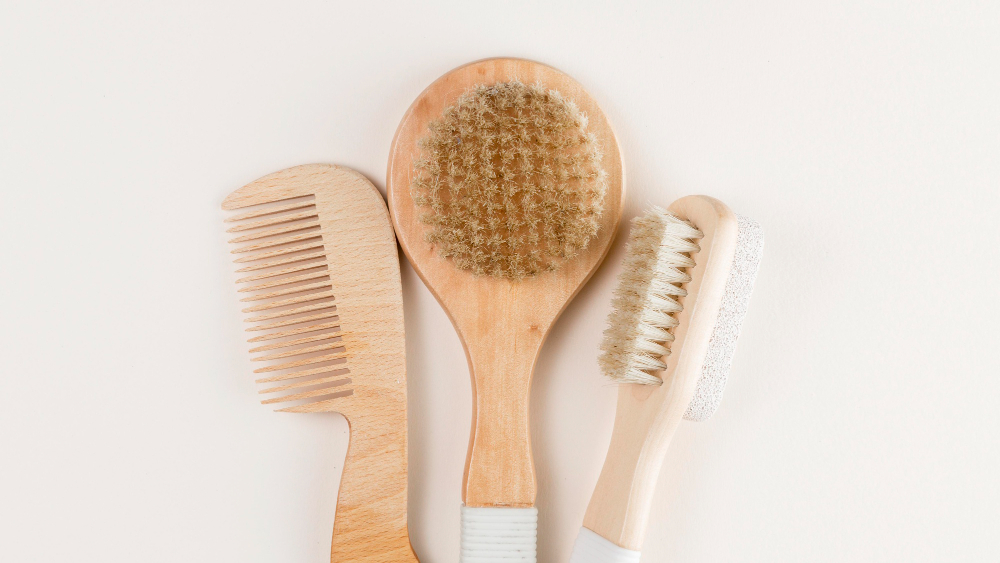
Hairbrushes are more than just styling tools – they’re essential to your hair care routine. But have you ever stopped to think about what might lurk in those bristles? Dust, oils, product residue, and even dead skin cells can accumulate over time, creating an unhealthy environment for your locks. Proper brush care isn’t just about extending the life of your tools; it’s about promoting the health of your hair. Join us on a journey through Brush Care 101, where we uncover the secrets to maintaining clean, hygienic hairbrushes for vibrant and healthy locks.
Beyond the Surface
Clean hairbrushes are more than a cosmetic luxury – they’re fundamental to hair care. When you use a dirty brush, you reintroduce old oils, dirt, and product buildup into your hair. This affects the appearance of your locks and compromises their health. Clean brushes ensure that you’re styling with tools that support your hair’s vitality rather than hindering it.
Know Your Bristles
Before we delve into cleaning, we must understand the types of brushes and bristles available. Each encounter serves a specific purpose, from natural boar bristles to synthetic options. Natural bristle brushes are excellent for distributing natural oils and promoting shine, while synthetic brushes are often better suited for detangling and managing wet hair. Knowing your brush type helps tailor your cleaning routine to its specific needs.
Removing Hair and Debris
Before diving into a deep cleaning session, remove the hair and debris accumulated in your brush. Using a comb or a designated brush cleaner, gently loosen and lift the hair from the bristles. This step prepares your meeting for a thorough clean and prevents excess hair from tangling around the follicles.
The Soap and Water Method
For routine cleaning, a simple soap and water method is effective. Fill a bowl with warm water and add a small amount of mild shampoo or liquid soap. Swirl the brush in the soapy water, gently agitating to dislodge dirt and oils. Avoid submerging the entire meeting, especially if it has a wooden handle. After a few minutes, rinse the brush under running water, ensuring that all the soap is removed.
Removing Stubborn Buildup
If your brush has been cleaned a while ago or has stubborn product buildup, a deep cleaning is in order. Start by removing as much hair as possible. Then, create a mixture of warm water and baking soda or vinegar. Dip an old toothbrush or a small cleaning brush into the mix and scrub the bristles, focusing on areas with buildup. Rinse thoroughly under running water.
Careful Cleaning Approach
Owning a natural bristle brush, such as a boar brush, requires special care to maintain its effectiveness. Natural bristles can be sensitive to water and may become damaged if soaked. Instead of submerging the entire meeting, use a damp cloth or cotton pad dipped in soapy water to gently clean the bristles. Wipe away dirt and buildup while preserving the integrity of the strands.
Allowing Brushes to Breathe
After cleaning, it’s crucial to let your brushes dry completely before using them again. Gently shake off excess water and pat the bristles with a clean towel to remove moisture. Place the encounter with the hairs facing down on a towel or drying rack to facilitate proper drying. Avoid standing the meeting upright, as water can seep into the brush’s base and damage the handle or cushion.
Tailoring to Your Routine
The frequency of brush cleaning depends on factors such as hair type, styling habits, and product usage. As a general guideline, aim to clean your brushes at least once a week for brushes you use daily. Brushes that you use less frequently can be cleaned once a month. However, adjust your cleaning schedule accordingly if you notice excess product buildup.
Maintaining Hygiene
Clean brushes deserve a neat storage space. Choose a dry, well-ventilated area to store your brushes, preferably away from the bathroom, where humidity can encourage bacterial growth. If possible, cover your meetings with a cloth or a brush cover to prevent dust from settling on the bristles.
Nurturing Your Brushes
To extend the life of your brushes and maintain their performance, consider these additional tips:
- Avoid Overloading with Product: Excessive product buildup can be challenging to remove and can compromise brush effectiveness.
- Regularly Replace Brushes: Just like any tool, brushes have a lifespan. Replace them when the bristles start to fray or lose their shape.
- Use a Comb for Hair Removal: A wide-tooth comb is an excellent tool for removing hair from your brushes between cleaning sessions.
The Art of Brush Care
Caring for your hairbrushes isn’t just a mundane chore – it’s essential to maintaining healthy, vibrant hair. Clean brushes ensure you’re styling with tools that enhance your hair’s natural beauty and vitality. By incorporating proper brush care into your hair care routine, you’re preserving the longevity of your brushes and fostering a healthy relationship between your hair and your styling tools. So, the next time you pick up your brush, remember that its cleanliness reflects your commitment to the health and radiance of your locks.

